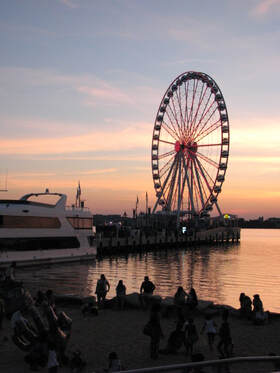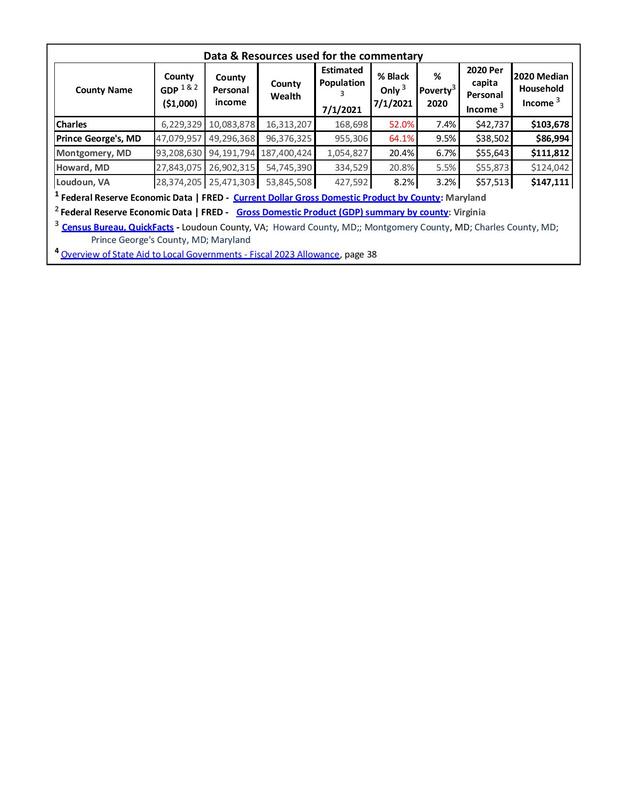
Recently, the Washington Post published an article “Is Prince George’s still the richest majority-Black county in America?” by Andrew Van Dam, who concluded, “It isn’t”. ”. A couple of weeks later, the U.S. News & World Report published a related article - “The 15 Richest Counties in the U.S”. These articles raised a red flag for me, because I thought my Prince George’s County, MD home was known as the “Wealthiest Majority-Black County in the U.S”, not the richest. So, is it?
I first confirmed the definitions for the richest and wealthiest as well as the definition for county wealth and found there are significant differences. Both articles limit their definition of the richest counties to median household income. Wealth often is defined as all things that have a monetary or exchange value (property, stocks, savings, etc.) including income. The federal government defines county wealth as the total county personal income plus the total county Gross Domestic Product (GDP) and Gross Domestic Product of a county is the total in Private & Producing Goods and Services plus Government & Government Enterprises. So, there is a significant difference among the definitions. (See Chart)
Using recent data from the widely accepted Federal Reserve Economic Data (FRED) and Census Bureau Quick Facts, I first confirmed that Mr. Van Dam (Post) was correct. Charles County, which only recently became majority-black (52%) thanks to migration from Prince George’s is now the richest majority-Black county in the U.S., but Prince George’s County is second. Charles County’s median household income is $104,000/ year versus only $86,000/year for Prince George’s– a $18,000/year difference! No other majority-Black county in the U.S. comes close even in the Atlanta region, but Charles and Prince George’s County are not among the richest in Maryland or the U.S.
Howard County, MD, which is only 20.8% black, has the highest median household income in Maryland, and is ranked #6 in the U.S. at $124,042/year, Loudoun County, VA is ranked #1 in the U.S. at $147,111/year – Black income is $127,000/year, but is only 8.2% black and four Virginia counties in the Washington, DC area (Loudoun, Falls Church, Fairfax, Arlington) are ranked within the top 7 richest in the U.S. 3 Charles and Prince George’s counties are not ranked and have a long way to go to close the median household income gap in Maryland, the DC region, or the U.S.
Prince George’s County by definition is still the wealthiest majority-Black county in the U.S.! The 2020 total county wealth of Prince George’s was six times more or $96.4 billion vs only $16.3 billion for Charles County due in part because Prince George’s 2021 estimated population is 955,300 vs only 168,700 for Charles. Montgomery County, MD total county wealth is twice as large as Prince George’s at about $189.1 billion. 1 However, Prince George’s is only ranked 15th in Maryland for Local Wealth Per Pupil (Factor Affecting Targeted Education Funding) 4 Worcester County, MD is #1 or 2 1/2 higher!
Prince George’s and Charles County both made significant progress during the past two decades, but as reported in 1999 by the Brookings Institution, “A Region Divided: The State of Growth in Greater Washington, D.C.” there is still a significant and inequitable divide west and east side of Washington, D.C. In addition, both articles address several other community quality and quantity indicators that are inadequate and inequitable compared to the Prince George’s and Charles County neighbors and the recently passed Blueprint for Maryland’s Future will not address or fix them alone.
In my view, public and community leaders with other stakeholders for both counties must work collaboratively to develop a consensus within and between their counties to improve their wealth, in-county revenue, household incomes, public services, and other amenities by prioritizing the attraction of more medium to large Private Goods and Services Producing Industries and support of the existing Government Enterprises increasing in-county jobs.
They must stop being “bedroom communities” by significantly limiting large, revenue/public service draining residential development unless they are located near Metro stations, transportation hubs or major employment centers. They must demand that the state and federal government adequately invest in the upgrade and safety improvements of the shared transit and highway corridors they share (MD 5, MD 210, US 301, and the Beltway) and attract higher quality goods and services along these underserved corridors. They also must upgrade the quality, quantity, and staffing of a range of public services accessible to all residents comparable to others in the region such as education, social services, and recreation.
What does this all mean? Read the contents in the included interactive links and ask your leaders and neighbors.
Rick Tyler, Jr. is a 30 year community and education advocate and leader with extensive research experience
SOURCES: Federal Reserve Economic Data (FRED)- Census Bureau Quick Facts- FY23 Overview of State Aid to Local Governments
I first confirmed the definitions for the richest and wealthiest as well as the definition for county wealth and found there are significant differences. Both articles limit their definition of the richest counties to median household income. Wealth often is defined as all things that have a monetary or exchange value (property, stocks, savings, etc.) including income. The federal government defines county wealth as the total county personal income plus the total county Gross Domestic Product (GDP) and Gross Domestic Product of a county is the total in Private & Producing Goods and Services plus Government & Government Enterprises. So, there is a significant difference among the definitions. (See Chart)
Using recent data from the widely accepted Federal Reserve Economic Data (FRED) and Census Bureau Quick Facts, I first confirmed that Mr. Van Dam (Post) was correct. Charles County, which only recently became majority-black (52%) thanks to migration from Prince George’s is now the richest majority-Black county in the U.S., but Prince George’s County is second. Charles County’s median household income is $104,000/ year versus only $86,000/year for Prince George’s– a $18,000/year difference! No other majority-Black county in the U.S. comes close even in the Atlanta region, but Charles and Prince George’s County are not among the richest in Maryland or the U.S.
Howard County, MD, which is only 20.8% black, has the highest median household income in Maryland, and is ranked #6 in the U.S. at $124,042/year, Loudoun County, VA is ranked #1 in the U.S. at $147,111/year – Black income is $127,000/year, but is only 8.2% black and four Virginia counties in the Washington, DC area (Loudoun, Falls Church, Fairfax, Arlington) are ranked within the top 7 richest in the U.S. 3 Charles and Prince George’s counties are not ranked and have a long way to go to close the median household income gap in Maryland, the DC region, or the U.S.
Prince George’s County by definition is still the wealthiest majority-Black county in the U.S.! The 2020 total county wealth of Prince George’s was six times more or $96.4 billion vs only $16.3 billion for Charles County due in part because Prince George’s 2021 estimated population is 955,300 vs only 168,700 for Charles. Montgomery County, MD total county wealth is twice as large as Prince George’s at about $189.1 billion. 1 However, Prince George’s is only ranked 15th in Maryland for Local Wealth Per Pupil (Factor Affecting Targeted Education Funding) 4 Worcester County, MD is #1 or 2 1/2 higher!
Prince George’s and Charles County both made significant progress during the past two decades, but as reported in 1999 by the Brookings Institution, “A Region Divided: The State of Growth in Greater Washington, D.C.” there is still a significant and inequitable divide west and east side of Washington, D.C. In addition, both articles address several other community quality and quantity indicators that are inadequate and inequitable compared to the Prince George’s and Charles County neighbors and the recently passed Blueprint for Maryland’s Future will not address or fix them alone.
In my view, public and community leaders with other stakeholders for both counties must work collaboratively to develop a consensus within and between their counties to improve their wealth, in-county revenue, household incomes, public services, and other amenities by prioritizing the attraction of more medium to large Private Goods and Services Producing Industries and support of the existing Government Enterprises increasing in-county jobs.
They must stop being “bedroom communities” by significantly limiting large, revenue/public service draining residential development unless they are located near Metro stations, transportation hubs or major employment centers. They must demand that the state and federal government adequately invest in the upgrade and safety improvements of the shared transit and highway corridors they share (MD 5, MD 210, US 301, and the Beltway) and attract higher quality goods and services along these underserved corridors. They also must upgrade the quality, quantity, and staffing of a range of public services accessible to all residents comparable to others in the region such as education, social services, and recreation.
What does this all mean? Read the contents in the included interactive links and ask your leaders and neighbors.
Rick Tyler, Jr. is a 30 year community and education advocate and leader with extensive research experience
SOURCES: Federal Reserve Economic Data (FRED)- Census Bureau Quick Facts- FY23 Overview of State Aid to Local Governments
